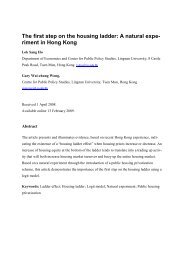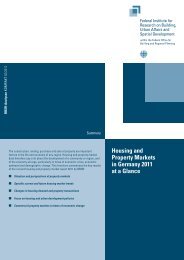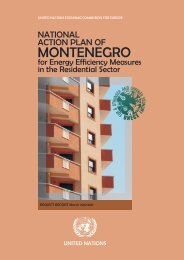housing developments in european countries - Department of ...
housing developments in european countries - Department of ...
housing developments in european countries - Department of ...
You also want an ePaper? Increase the reach of your titles
YUMPU automatically turns print PDFs into web optimized ePapers that Google loves.
Section 1<br />
Introduction and Summary<br />
Introduction and Summary Section 1<br />
Table<br />
1.4.5<br />
Country<br />
Austria<br />
Bulgaria<br />
Cyprus<br />
Czech Republic<br />
Denmark<br />
Estonia<br />
F<strong>in</strong>land<br />
France<br />
Germany<br />
Hungary<br />
Ireland<br />
Italy<br />
Latvia<br />
Lithuania<br />
Luxembourg<br />
Malta<br />
Netherlands<br />
Poland<br />
Portugal<br />
Romania<br />
Slovakia<br />
Slovenia<br />
Spa<strong>in</strong><br />
Sweden<br />
Disequilibrat<strong>in</strong>g Factors <strong>in</strong> Hous<strong>in</strong>g Markets <strong>in</strong> European Countries up to 2004<br />
Disequilibrat<strong>in</strong>g Factors<br />
Reduced central government subsidies towards local government supports for house build<strong>in</strong>g and refurbishment may reduce supply<br />
and <strong>in</strong>crease prices.<br />
Low household <strong>in</strong>comes mean that demand for <strong>hous<strong>in</strong>g</strong> is not supported by purchas<strong>in</strong>g power and consequently supply is low.<br />
The cont<strong>in</strong>ually ris<strong>in</strong>g construction cost is due to the general ris<strong>in</strong>g cost <strong>of</strong> land materials and petrol, and lack <strong>of</strong> availability <strong>of</strong> labour.<br />
The lack <strong>of</strong> private sector <strong>in</strong>volvement <strong>in</strong> rental <strong>hous<strong>in</strong>g</strong> construction is compounded by the impact <strong>of</strong> rent control measures and<br />
shortcom<strong>in</strong>gs <strong>in</strong> government supports for <strong>hous<strong>in</strong>g</strong> construction.<br />
Rent control <strong>in</strong>hibits mobility <strong>in</strong> the <strong>hous<strong>in</strong>g</strong> market and discourages the construction <strong>of</strong> private rented dwell<strong>in</strong>gs.<br />
The impact <strong>of</strong> the plann<strong>in</strong>g process, particularly <strong>in</strong> rural areas, means that the build<strong>in</strong>g process is quite a time-consum<strong>in</strong>g activity.<br />
Low <strong>in</strong>terest rate environment drives demand for owner-occupied <strong>hous<strong>in</strong>g</strong>. There is <strong>in</strong>sufficient construction <strong>in</strong> high demand areas.<br />
Increas<strong>in</strong>g land prices impede social house build<strong>in</strong>g.<br />
There is over-supply <strong>of</strong> social <strong>hous<strong>in</strong>g</strong> and affordable private <strong>hous<strong>in</strong>g</strong> <strong>in</strong> some areas and under-supply <strong>in</strong> others. Demand for second<br />
homes has led to problems for local residents.<br />
There are <strong>in</strong>creases <strong>in</strong> development land prices, particularly <strong>in</strong> the west <strong>of</strong> the country.<br />
Limited mobility is evident among exist<strong>in</strong>g home owners. Low average <strong>in</strong>comes mean that demand is not supported by purchas<strong>in</strong>g<br />
power.<br />
Factors <strong>in</strong>clude: high <strong>in</strong>flation and shortage <strong>of</strong> skills <strong>in</strong> the construction <strong>in</strong>dustry, shortage <strong>of</strong> serviced build<strong>in</strong>g land <strong>in</strong> high demand<br />
areas and capacity problems <strong>in</strong> the spatial plann<strong>in</strong>g system.<br />
Supply <strong>of</strong> rental accommodation is <strong>in</strong>sufficient to meet demand. There are <strong>hous<strong>in</strong>g</strong> access problems among disadvantaged groups and<br />
problems with the provision and management <strong>of</strong> social <strong>hous<strong>in</strong>g</strong>.<br />
Low household <strong>in</strong>comes mean that demand for <strong>hous<strong>in</strong>g</strong> is not supported by purchas<strong>in</strong>g power; other factors <strong>in</strong>clude <strong>in</strong>sufficiently<br />
developed f<strong>in</strong>ancial system and legislative arrangements; construction <strong>of</strong> non-residential <strong>developments</strong> rather than dwell<strong>in</strong>gs.<br />
There has been a sharp reduction <strong>in</strong> construction activity, due to a fall <strong>in</strong> direct fund<strong>in</strong>g by the State for this sector and the failure <strong>of</strong><br />
the private sector to compensate for the withdrawal <strong>of</strong> fund<strong>in</strong>g. Low average <strong>in</strong>comes mean demand is not supported by purchas<strong>in</strong>g<br />
power. The costs <strong>of</strong> new <strong>in</strong>frastructure are high. There is a limited supply <strong>of</strong> development land and there are unresolved issues <strong>in</strong><br />
relation to land restitution. Local authorities are slow <strong>in</strong> prepar<strong>in</strong>g land-use plann<strong>in</strong>g documents.<br />
Demand is compounded by population growth and a ris<strong>in</strong>g number <strong>of</strong> households. Supply has been restricted by the high price <strong>of</strong><br />
development land and high construction costs. An <strong>in</strong>creas<strong>in</strong>g number <strong>of</strong> households are encounter<strong>in</strong>g difficulties <strong>in</strong> secur<strong>in</strong>g f<strong>in</strong>ance for<br />
a new build<strong>in</strong>g.<br />
Factors <strong>in</strong>clude: shortage <strong>of</strong> land for development and a limited use <strong>of</strong> high-rise construction; high levels <strong>of</strong> vacant and dilapidated<br />
properties unavailable to those <strong>in</strong> need <strong>of</strong> <strong>hous<strong>in</strong>g</strong>. Although rent control legislation has been liberalised, rema<strong>in</strong><strong>in</strong>g provisions <strong>in</strong> this<br />
regard are still distort<strong>in</strong>g the market.<br />
Economic stagnation has made consumers unwill<strong>in</strong>g to <strong>in</strong>vest <strong>in</strong> <strong>hous<strong>in</strong>g</strong>. Therefore sell<strong>in</strong>g and buy<strong>in</strong>g dwell<strong>in</strong>gs <strong>in</strong> the more expensive<br />
segment <strong>of</strong> the market has become more difficult. This has led to a lack <strong>of</strong> mobility <strong>in</strong> the <strong>hous<strong>in</strong>g</strong> market which has impeded access<br />
by new households.<br />
There are problems <strong>in</strong> access<strong>in</strong>g mortgage credit.<br />
Factors <strong>in</strong>clude: scarcity <strong>of</strong> build<strong>in</strong>g land and high land prices <strong>in</strong> areas <strong>of</strong> high <strong>hous<strong>in</strong>g</strong> demand; excessive bureaucracy associated with<br />
construction.<br />
Factors <strong>in</strong>clude the high cost <strong>of</strong> build<strong>in</strong>g materials caused by a monopoly <strong>in</strong> the construction sector, and high tariffs on imported<br />
materials; <strong>in</strong>adequate supply <strong>of</strong> development land <strong>in</strong> urban areas.<br />
Low household <strong>in</strong>comes restrict demand. Other factors <strong>in</strong>clude: limited availability <strong>of</strong> serviced build<strong>in</strong>g land <strong>in</strong> high demand areas,<br />
<strong>in</strong>determ<strong>in</strong>ate ownership status <strong>of</strong> land; <strong>in</strong>sufficient supply <strong>of</strong> affordable <strong>hous<strong>in</strong>g</strong> suitable for first-time buyers and older people.<br />
Factors <strong>in</strong>clude: difficulties <strong>in</strong> f<strong>in</strong>anc<strong>in</strong>g construction and <strong>in</strong>adequate supply <strong>of</strong> serviced build<strong>in</strong>g land, particularly <strong>in</strong> urban areas.<br />
There is a limited supply <strong>of</strong> development land <strong>in</strong> cities where demand is greatest.<br />
Factors <strong>in</strong>clude: a low <strong>hous<strong>in</strong>g</strong> output <strong>in</strong> high demand areas caused by a shortage <strong>of</strong> serviced land and high build<strong>in</strong>g costs;<br />
impediments related to the plann<strong>in</strong>g system <strong>in</strong>clud<strong>in</strong>g the level <strong>of</strong> appeals and the reluctance <strong>of</strong> some local authorities to <strong>in</strong>crease the<br />
local population for fear <strong>of</strong> ris<strong>in</strong>g costs for municipal services.<br />
Turkey There are difficulties aris<strong>in</strong>g from procurement legislation such as the need for a very lengthy bidd<strong>in</strong>g process. Lack <strong>of</strong> availability <strong>of</strong><br />
mortgage loans and f<strong>in</strong>ance, and <strong>of</strong> land, has impeded private and public sector construction.<br />
United K<strong>in</strong>gdom There is a shortage <strong>of</strong> skilled workers <strong>in</strong> the construction <strong>in</strong>dustry, particularly <strong>in</strong> the home build<strong>in</strong>g sector.<br />
Note: A more detailed version <strong>of</strong> this table is <strong>in</strong>cluded <strong>in</strong> Section 4 <strong>of</strong> the ma<strong>in</strong> report. Information for Belgium and Greece is not available.<br />
political and economic<br />
reorganisation <strong>in</strong> the early 1990s<br />
and have not s<strong>in</strong>ce returned to the<br />
levels <strong>of</strong> earlier decades.<br />
Section 4 <strong>of</strong> this report reveals that<br />
<strong>in</strong> recent years new <strong>hous<strong>in</strong>g</strong> output<br />
across Europe has been dom<strong>in</strong>ated<br />
by the private sector and that there<br />
has been an associated decl<strong>in</strong>e <strong>in</strong><br />
social <strong>hous<strong>in</strong>g</strong> construction <strong>in</strong> both<br />
relative and absolute terms. In<br />
most <strong>countries</strong> the majority <strong>of</strong> new<br />
<strong>hous<strong>in</strong>g</strong> construction takes place <strong>in</strong><br />
urban areas, although <strong>in</strong> the<br />
<strong>countries</strong> surround<strong>in</strong>g the<br />
Mediterranean, output <strong>of</strong> second<br />
homes adjacent to holiday resorts<br />
is also high. However, <strong>in</strong> most<br />
European <strong>countries</strong>, the level <strong>of</strong><br />
new house construction <strong>in</strong> the<br />
largest and most economically<br />
successful urban areas falls short<br />
<strong>of</strong> demand.<br />
In the survey on which this report<br />
is based, a wide range <strong>of</strong> causes <strong>of</strong><br />
<strong>hous<strong>in</strong>g</strong> market disequilibrium<br />
were identified by <strong>hous<strong>in</strong>g</strong><br />
m<strong>in</strong>istries. These <strong>in</strong>clude:<br />
Figure<br />
1.4.2<br />
Note:<br />
■ the relative <strong>in</strong>elasticity <strong>of</strong> <strong>hous<strong>in</strong>g</strong> supply changes <strong>in</strong><br />
response to demand fluctuations;<br />
■ overall economic and demographic conditions<br />
which dictate the strength <strong>of</strong> <strong>hous<strong>in</strong>g</strong> demand;<br />
■ specific government policies that have either<br />
curtailed or augmented the demand for, and<br />
supply <strong>of</strong> <strong>hous<strong>in</strong>g</strong>;<br />
■ scarcity <strong>of</strong> development land, particularly <strong>in</strong> urban<br />
areas;<br />
■ the operation <strong>of</strong> land-use plann<strong>in</strong>g, procurement<br />
and build<strong>in</strong>g control systems;<br />
■ rent controls which are a significant impediment to<br />
<strong>in</strong>vestment <strong>in</strong> the private rented sector, and<br />
% Share <strong>of</strong> Household Income or Expenditure Devoted<br />
to Hous<strong>in</strong>g Costs <strong>in</strong> European Countries, Various Years<br />
Malta<br />
United K<strong>in</strong>gdom<br />
Slovenia<br />
Estonia<br />
Czech Republic<br />
Lithuania<br />
Slovakia<br />
Portugal<br />
Netherlands<br />
Germany<br />
Sweden<br />
Denmark<br />
France<br />
Italy<br />
Poland<br />
Austria<br />
Belgium<br />
8.4<br />
9.69<br />
10.8<br />
The methods used to assess <strong>hous<strong>in</strong>g</strong> expenditure varies significantly across Europe. See TABLE 4.8.1 <strong>in</strong><br />
the ma<strong>in</strong> body <strong>of</strong> this report for full details <strong>of</strong> the data on which this graph is based.<br />
16<br />
17.2<br />
18<br />
19.6<br />
19.8<br />
■ <strong>in</strong>creas<strong>in</strong>g construction costs and a lack <strong>of</strong> suitably<br />
skilled labour.<br />
The specific disequilibrat<strong>in</strong>g factors which are <strong>of</strong> most<br />
significance <strong>in</strong> the <strong>in</strong>dividual <strong>countries</strong> under<br />
exam<strong>in</strong>ation are summarised <strong>in</strong> TABLE 1.4.5.<br />
The <strong>in</strong>teraction between <strong>hous<strong>in</strong>g</strong> supply and demand<br />
also has implications for <strong>hous<strong>in</strong>g</strong> affordability. The<br />
available <strong>in</strong>formation on the proportion <strong>of</strong> <strong>in</strong>come or<br />
expenditure which households <strong>in</strong> European <strong>countries</strong><br />
devote to <strong>hous<strong>in</strong>g</strong> expenditure is summarised <strong>in</strong> FIGURE<br />
1.4.2. However, variations <strong>in</strong> the methods used to<br />
assess <strong>hous<strong>in</strong>g</strong> expenditure mean that direct<br />
comparisons between <strong>countries</strong> can be made on the<br />
basis <strong>of</strong> this <strong>in</strong>formation. Nevertheless some broad<br />
trends can be identified. One clear trend evident from<br />
21<br />
21.7<br />
22<br />
22<br />
22.5<br />
24.7<br />
24.8<br />
24.5<br />
26.6<br />
14 European Union Report<br />
Regular National Report on Hous<strong>in</strong>g Developments <strong>in</strong> European Countries<br />
15

















